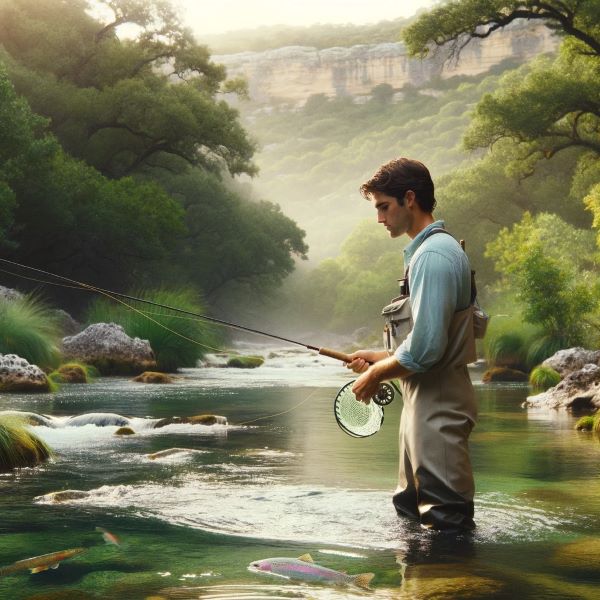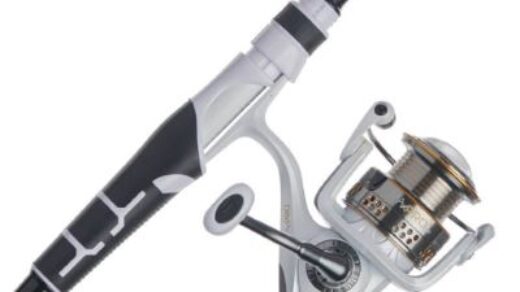
Nestled amidst the diverse landscapes of Texas lies a hidden gem for angling enthusiasts: trout fishing. While Texas may not be the first destination that comes to mind for trout fishing, its picturesque rivers, streams, and lakes offer a haven for those seeking the thrill of reeling in these prized freshwater species. In this article, we delve into the rich tapestry of trout fishing in Texas, uncovering the serene beauty of its waterways and the bounty they hold for avid anglers. From the tranquil Hill Country streams to the cool depths of highland reservoirs, join us on an exploration of Texas’s vibrant trout fishing scene, where each cast holds the promise of adventure and the chance to connect with nature in its purest form.
Trout Species and Habitats in Texas
In the diverse ecosystem of Texas, anglers can encounter several species of trout, each thriving in its preferred habitat. Among the most sought-after species are the Rainbow Trout, Brown Trout, and Brook Trout, each offering a unique angling experience.
Rainbow Trout, characterized by their vibrant colors and energetic fights, are often stocked in Texas’s cold-water rivers and streams. These resilient fish are well-suited to the state’s varying climate, thriving in the cool waters of spring-fed creeks and tailwaters. Anglers can test their skills against these acrobatic fighters, known for their aerial displays and spirited runs.
Brown Trout, revered for their elusive nature and wily behavior, inhabit select rivers and reservoirs across Texas. Preferring clear, cool waters with ample cover, Brown Trout present a challenge for anglers seeking a more strategic approach. Stealth and patience are key when targeting these cunning predators, which often lurk in deep pools and under overhanging vegetation.
Brook Trout, with their distinctive markings and preference for pristine mountain streams, offer a unique angling experience in Texas’s highland regions. While less common than Rainbow and Brown Trout, Brook Trout can be found in select cold-water habitats, where they thrive amidst the tranquil beauty of forested landscapes. Anglers willing to venture off the beaten path can be rewarded with the opportunity to reel in these exquisite fish, prized for their beauty and tenacity.
Understanding the habitats preferred by each trout species is essential for successful angling in Texas. From the clear, swift-flowing streams of the Guadalupe River to the remote reaches of the Sabinal River, anglers have ample opportunities to explore diverse habitats and hone their skills. Whether casting dry flies on a mountain stream or drifting nymphs through a deep pool, each encounter with Texas’s trout species is a testament to the state’s natural splendor and the enduring allure of angling.
Prime Trout Fishing Destinations in Texas
When it comes to trout fishing in Texas, anglers are spoilt for choice with a plethora of prime destinations scattered across the state. Whether you’re a seasoned angler or a novice enthusiast, there’s a trout fishing spot in Texas waiting to be explored. Below, we’ve compiled a list of some of the top trout fishing destinations, each offering its own unique charm and angling opportunities:
| Destination | Description |
| Guadalupe River | Renowned for its year-round trout fishery, the Guadalupe River boasts cool, clear waters teeming with Rainbow and Brown Trout. Anglers can enjoy both wade and float fishing. |
| Canyon Lake | Nestled amidst the scenic Hill Country, Canyon Lake offers pristine waters and abundant trout populations. Shoreline access and boat rentals make it accessible to all anglers. |
| Pedernales River | A tributary of the Colorado River, the Pedernales River is home to native and stocked trout, providing anglers with a tranquil setting for fly fishing and light tackle pursuits. |
| Blue River | Located in the picturesque Davis Mountains, the Blue River offers a remote and secluded trout fishing experience. Anglers can enjoy solitude and stunning scenery. |
| Lake Texoma | While primarily known for its striped bass fishery, Lake Texoma also supports a thriving population of stocked Rainbow Trout, making it a popular destination for multi-species anglers. |
Essential Gear and Techniques for Trout Fishing in Texas
To maximize your success and enjoyment while trout fishing in Texas, it’s crucial to have the right gear and employ effective techniques. Below, we outline the essential equipment and methods for a rewarding angling experience:
- Fly Fishing Gear:
- Fly Rod: Opt for a lightweight, responsive fly rod in the 3 to 5-weight range for targeting trout in Texas’s streams and rivers.
- Fly Reel: Choose a reel with a smooth drag system and sufficient capacity to accommodate your fly line and backing.
- Fly Line: Select a weight-forward floating fly line matched to your rod weight for casting accuracy and control.
- Flies: Stock your fly box with a variety of dry flies, nymphs, and streamers to match the hatch and entice trout in different conditions.
- Spin Fishing Equipment:
- Spinning Rod: Utilize a medium-action spinning rod paired with a lightweight reel for casting versatility and sensitivity.
- Fishing Line: Opt for monofilament or fluorocarbon line in the 4 to 8-pound test range, depending on the size of trout and fishing conditions.
- Lures: Experiment with inline spinners, spoons, and soft plastics to mimic natural prey and trigger strikes from trout.
- Bait Fishing Gear:
- Fishing Rod: Choose a sensitive yet sturdy baitcasting or spinning rod capable of handling live bait rigs and weighted setups.
- Hooks: Use small to medium-sized hooks (size 8 to 14) for presenting live bait such as worms, crickets, or salmon eggs to trout.
- Weight: Attach split shot or fishing weights above your hook to achieve the desired depth and control the presentation of your bait.
- Techniques:
- Drift Fishing: Allow your bait or lure to drift naturally with the current, particularly when fishing in rivers and streams. Adjust your drift speed and depth to target active feeding zones.
- Sight Fishing: Polarized sunglasses can aid in spotting trout in clear water and targeting specific individuals with precision casts.
- Presentation: Pay attention to your casting accuracy, line control, and retrieve speed to mimic natural movements and entice strikes from trout.
- Depth Control: Experiment with different depths and retrieve speeds to determine the optimal presentation for enticing trout in varying water conditions.
Conservation and Sustainability Practices for Trout Fishing in Texas
Trout fishing in Texas not only provides anglers with thrilling outdoor experiences but also relies on responsible stewardship to ensure the long-term health of trout populations and their habitats. Conservation and sustainability practices play a vital role in preserving the natural beauty and abundance of Texas’s waterways. Below are key initiatives and strategies aimed at promoting the conservation of trout fisheries:
- Catch and Release Guidelines:
- Anglers are encouraged to practice catch and release to help maintain healthy trout populations and preserve the genetic diversity of native species.
- Use barbless hooks to minimize injury and facilitate the safe release of trout.
- Handle fish carefully, keeping them in the water as much as possible to reduce stress and increase their chances of survival upon release.
- Habitat Restoration Projects:
- Collaborate with local conservation organizations and government agencies to participate in habitat restoration efforts, including streambank stabilization, riparian vegetation planting, and in-stream habitat enhancements.
- Volunteer for stream clean-up events to remove litter and debris that can degrade water quality and harm aquatic ecosystems.
- Invasive Species Management:
- Help prevent the spread of invasive species by thoroughly cleaning and drying fishing gear and watercraft between trips to different water bodies.
- Report sightings of invasive species to relevant authorities and follow guidelines for their removal and control to minimize their impact on native trout populations.
- Water Quality Monitoring:
- Support efforts to monitor water quality in trout habitats and advocate for policies that protect clean water sources from pollution and runoff.
- Participate in citizen science programs to collect data on water quality parameters and contribute to ongoing research and conservation initiatives.
- Educational Outreach:
- Promote awareness of conservation issues among anglers and the general public through educational outreach programs, workshops, and informational materials.
- Emphasize the importance of responsible angling practices, environmental stewardship, and sustainable fisheries management in preserving trout habitats for future generations.
Regulations and Licensing for Trout Fishing in Texas
As with any form of recreational fishing, trout fishing in Texas is governed by a set of regulations and licensing requirements designed to conserve fish populations, protect natural resources, and ensure a sustainable angling experience for all. Understanding and adhering to these regulations is essential for anglers to enjoy their time on the water while respecting the environment and fellow anglers. Below, we outline the key regulations and licensing considerations for trout fishing in Texas:
- Fishing Licenses:
- Anglers aged 17 and older are required to possess a valid Texas fishing license to fish in public waters, including those designated for trout fishing.
- Texas offers various fishing license options, including freshwater, saltwater, and all-water packages, with different durations and privileges to suit individual angler needs.
- Special licenses or permits may be required for certain trout fishing locations or activities, such as fishing in designated trout parks or participating in guided fishing trips on private waters.
- Trout Stamp Endorsement:
- In addition to a standard fishing license, anglers targeting freshwater trout species, including Rainbow Trout and Brown Trout, must purchase a freshwater fishing stamp endorsement.
- The freshwater stamp endorsement helps fund trout stocking programs, habitat restoration projects, and conservation efforts aimed at maintaining healthy trout populations in Texas waters.
- Seasons and Bag Limits:
- Trout fishing seasons and bag limits vary depending on the specific water body, species, and stocking schedule established by the Texas Parks and Wildlife Department (TPWD).
- Anglers should consult the TPWD Outdoor Annual or visit the official TPWD website for up-to-date information on trout fishing regulations, including opening dates, closing dates, and daily possession limits for trout.
- Special Regulations:
- Some trout fishing destinations in Texas may have special regulations or restrictions in place to protect sensitive trout populations or enhance angling opportunities.
- Examples of special regulations include catch-and-release zones, artificial lure-only waters, and fly fishing-only sections, which aim to conserve trout fisheries and promote selective harvest practices.
- Ethical Angling Practices:
- In addition to regulatory requirements, anglers are encouraged to practice ethical angling behavior, including proper fish handling, respect for wildlife and habitat, and adherence to leave-no-trace principles while enjoying the outdoors.
Conclusion:
Trout fishing in Texas offers anglers a rich tapestry of experiences, from the serene beauty of mountain streams to the expansive waters of reservoirs nestled in the heart of the Lone Star State. As we conclude our exploration of this vibrant angling scene, it’s evident that trout fishing in Texas is not just a pastime but a journey of discovery, connection, and stewardship.
Throughout our journey, we’ve navigated the winding rivers, cast our lines into crystalline waters, and felt the exhilarating tug of trout on the other end. We’ve marveled at the diversity of trout species, from the vibrant hues of Rainbow Trout to the elusive nature of Brown Trout and the pristine beauty of Brook Trout. Each encounter with these prized fish has left an indelible mark on our angling memories, reminding us of the magic that awaits in Texas’s wilderness.
Yet, trout fishing in Texas is more than just the pursuit of trophy catches; it’s a testament to the importance of conservation and sustainability in preserving our natural heritage. Through responsible angling practices, habitat restoration efforts, and adherence to regulations, anglers play a crucial role in safeguarding the future of trout fisheries for generations to come.
As we bid farewell to the tranquil waters and majestic landscapes that define trout fishing in Texas, let us carry forward the lessons learned and the memories made. Whether casting lines on a sun-dappled stream or gazing out across a tranquil lake at sunset, may we always cherish the beauty of nature and the privilege of experiencing it firsthand through the art of fishing. Until next time, tight lines and happy angling!




